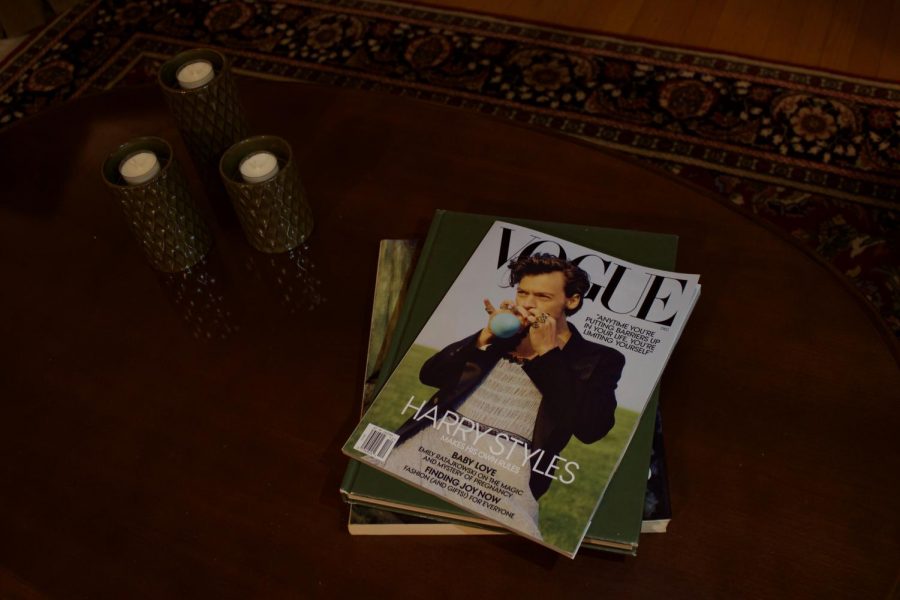Stop Defining Clothing As Masculine and Feminine
No one has the power to tell others what they can and can’t wear.
January 13, 2021
Pink is known as a “feminine” color, while blue is seen as “masculine.” And dresses are equated to women, while suits are supposedly for men. It’s time to ask ourselves, “Why?”
Gender is a social construct that should not confine us to certain types of clothes, yet we are still fighting battles about this topic. The clothing you wear does not relate to the sex you were born as or gender you identify with. Clothes should not be associated with gender.
On Nov. 13, the December issue of American Vogue was released to the public, featuring Harry Styles as the first male to be photographed solo on the cover since the magazine was first published in 1892. And instead of focusing on and celebrating the huge achievement for Styles and the growth Vogue showed, many people got stuck on one thing — his outfit.
Styles was pictured wearing a custom-made blue Gucci gown.
Since the release of this edition of Vogue, conversation has sparked as to whether Styles should have been wearing a dress in the first place, because he is a male. But since when did a person’s gender specify what type of clothing they should wear?
Candace Owens, a conservative activist, turned to Twitter to voice her own opinion on the matter, claiming the phrase “Bring back manly men.” She was stating her opinion that Styles should not be wearing a dress, and that by wearing it, he is losing part of his masculinity. Since the tweet, Owens has continued to outwardly discuss her thoughts on multiple social media platforms.
When I first read Owens’ tweets, I was taken aback by her choice of words and blatant attack on men who wear dresses. Don’t get me wrong, I am a huge fan of Styles, but it wasn’t just the fact that she was talking about his cover that made me mad. Owens’ comments were offensive to all of the young boys and men who wish to wear dresses.
It should also be noted that Owens has broken gender norms surrounding clothing in the past. She has been seen in pantsuits that, about 100 years ago, would not be socially acceptable for women to wear. I wonder how Owens could say that it is alright for herself to dress outside the norm, but not for men like Styles.
After the controversy began, news spread rapidly and found its way onto many different social media platforms, including TikTok. One creator on the app, Charlotte Sands, wrote a song about the situation called “Dress.” It has since become a popular song, which other creators have used in their own videos to demonstrate that clothing is not gender-specific.
From my perspective, Styles has been changing the way that people see clothing and gender for years. This wasn’t the first time he wore a dress, and it most likely won’t be the last.
In the cover story for his Vogue edition, Styles speaks his mind on clothing and what it means to him. “Clothes are there to have fun with and experiment with and play with,” he said. “What’s really exciting is that all of these lines are just crumbling away.”
Styles is not the first male celebrity to break away from gender norms, either. Rock and roll legends Freddie Mercury, Kurt Cobain, and David Bowie all played roles in changing the way that clothing is viewed in relation to gender. Billy Porter, Jaden Smith, and Jonathan Van Ness have all freely worn dresses and skirts to red carpet events, too. And even YouTuber Logan Paul came to Styles’ defense in a podcast, asking critics, “Is ‘manly’ being comfortable in your own skin, and being comfortable with who you are, regardless of what people think about what you’re wearing?”
As a society, it is essential that we continue evolving and changing the way we look at gender. Colors and clothes play no role in how a person identifies.
When you realize that what you wear doesn’t have to directly correlate to or be dictated by your gender, you are able to open up so many new possibilities that were not there before. You won’t be confined to certain colors or garments and can live freely and openly.
No one has the power to tell others what they can and can’t wear. If you feel comfortable in what you are wearing, then wear it.





